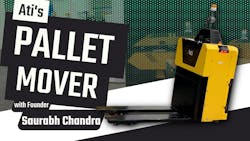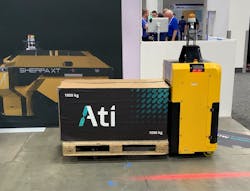Avoiding Obstacles: Ati’s Pallet Mover AMR Simplifies Automation on Existing Floors
Key Highlights:
- Ati Motors’ AMRs feature advanced sensor stacks combining LiDAR, cameras and IMUs for comprehensive environment mapping and obstacle detection.
- The company emphasizes a full-stack design approach, integrating hardware and software to optimize performance, safety, and ease of deployment.
- Their 3D navigation technology enables robots to operate on any surface without relying on floor markers, reflecting industry-standard capabilities.
From AI-powered vision to dynamic rerouting, today’s autonomous mobile robots (AMRs) are outpacing traditional fixed path automated guided vehicles.
But not all AMRs are created equal. For indoor logistics applications, the most capable machines blend 3D perception and sensor fusion with fleet orchestration, flexible redeployment, human‑aware safety and rapid, low-infrastructure deployment.
These capabilities are table stakes for Saurabh Chandra, founder of Ati Motors. Since launching the company in 2017, Chandra has focused on building AMRs for factories and warehouses.
“When we first entered the market, we were pioneers in thinking that AMR should go anywhere and operate on any type of surface,” Chandra told Machine Design. That philosophy, he added, is becoming an industry standard.
Ati Motors takes a full-stack approach to robot design. “Everything—from the electronics to the mechanical design to the software—is developed with this goal in mind,” Chandra explained.
At the heart of Ati’s AMRs are advanced sensor stacks and onboard AI. By combining 3D LiDAR, cameras and inertial measurement units (IMUs) with intelligent software, the robots can detect pallets, overhead obstacles and floor-level hazards while continuously rerouting in real time.
A standout feature is Ati’s 3D navigation technology, which constructs dense environmental maps using full-stack sensors and AI-based pallet detection. This allows the robots to adapt to changes without relying on floor markers, reflectors or QR codes. According to Chandra, the system achieves accuracy “in the high triple nines.”
Bridging Self-Driving Vehicles and Mobile Robotics
There is a common perception that mobile robotics and self-driving car technologies are converging. Chandra agrees: Advancements in sensing, perception and autonomy in one field influence the other. Today’s mobile robots feature improved suspension systems, greater wheel tolerances and ruggedized designs with increased ground clearance to handle diverse surfaces.
You’re also seeing more 3D sensing in applications, Chandra said. Across both the mechanical and sensor domains, there is a clear trend toward fusing vision and LiDAR rather than relying on a single sensor type.
READ MORE: Human-Robot Collaboration Gains Momentum
While 2D LIDAR was once ubiquitous, it is gradually being phased out. Many systems still use it due to legacy installations and existing safety certifications. However, these devices were originally designed for static safety curtains in robot cages and were never intended for the complex navigation demands of current mobile applications.
As AMR standards evolve, designers are adopting a more holistic approach. Modern AMRs integrate multiple sensing modalities to meet both performance and safety requirements without compromise.
A Pragmatic Approach to Autonomy
Ati Motors takes a balanced approach to autonomy, combining AI-driven perception with deterministic, rule-based control algorithms. “There are things which AI does very well, but there are still things classical techniques are very, very good at, such as repeatability and accuracy,” said Chandra. “AI is very good at handling variability.”
Rather than relying solely on AI, Ati blends both approaches to achieve high reliability. “We try to combine these two techniques to ensure we can deliver the 99%+ repeatability and accuracy that customers in manufacturing specifically demand,” he added.
The Sherpa Pallet Mover 1.5T exemplifies this philosophy. Equipped with advanced 3D LiDAR sensors, VDA 5050 fleet integration and Industry 4.0 readiness, the AMR can autonomously lift and transport payloads of up to 1.5 tons. Its onboard autonomy software continuously adjusts speed and trajectory in real time based on obstacle positioning.
READ MORE: AI-Powered Pallet Jack Detects Warehouse Obstacles
Chandra emphasized that the software modulates velocity to ensure safe operation and compliance with ISO 3691, the standard governing industrial trucks and mobile robotic systems. A swappable 48V NMC lithium-ion battery provides eight hours of runtime, supporting extended operation across multiple shifts. Together, these features enable safe, reliable and fully autonomous navigation in busy warehouse environments.
Robot-as-a-Service
To reduce barriers to adoption, Ati Motors offers its robots through a Robot-as-a-Service (RaaS) model. Instead of purchasing the robots outright, customers subscribe to a service that includes hardware, software, sensors and maintenance.
This model reflects a broader trend in industrial and service robotics, where automation is becoming more accessible by eliminating high upfront costs. In the U.S., factors such as labor shortages, the rise of e-commerce and the growth of AI-driven robotics are accelerating RaaS adoption.
For Ati’s customers, the benefits are immediate. “There’s basically no total cost of ownership calculation and payback period,” Chandra said. “The robots can run across three shifts and are very affordable to deploy and maintain.”
High Autonomy, Low Disruption on Existing Floors
Ease of deployment is another core design principle for Ati’s AMRs. “We don’t want our customers to change anything for robots to work,” Chandra explained. “That’s where our mindset of taking self-driving cars as a reference comes in.”
READ MORE: Automate 2024: Pallet Handling Systems from mk North America Inc.
“A [self-driving vehicle] doesn’t ask you to change the road and similarly, we don’t ask any of our customers to change their flooring or add markers.”
With Ati’s robots in more than 70 factories worldwide—navigating freely with “not a single guiding sticker anywhere”—the company is proving that high autonomy can coexist with minimal disruption to existing operations.
About the Author

Rehana Begg
Editor-in-Chief, Machine Design
As Machine Design’s content lead, Rehana Begg is tasked with elevating the voice of the design and multi-disciplinary engineer in the face of digital transformation and engineering innovation. Begg has more than 24 years of editorial experience and has spent the past decade in the trenches of industrial manufacturing, focusing on new technologies, manufacturing innovation and business. Her B2B career has taken her from corporate boardrooms to plant floors and underground mining stopes, covering everything from automation & IIoT, robotics, mechanical design and additive manufacturing to plant operations, maintenance, reliability and continuous improvement. Begg holds an MBA, a Master of Journalism degree, and a BA (Hons.) in Political Science. She is committed to lifelong learning and feeds her passion for innovation in publishing, transparent science and clear communication by attending relevant conferences and seminars/workshops.
Follow Rehana Begg via the following social media handles:
X: @rehanabegg
LinkedIn: @rehanabegg and @MachineDesign



